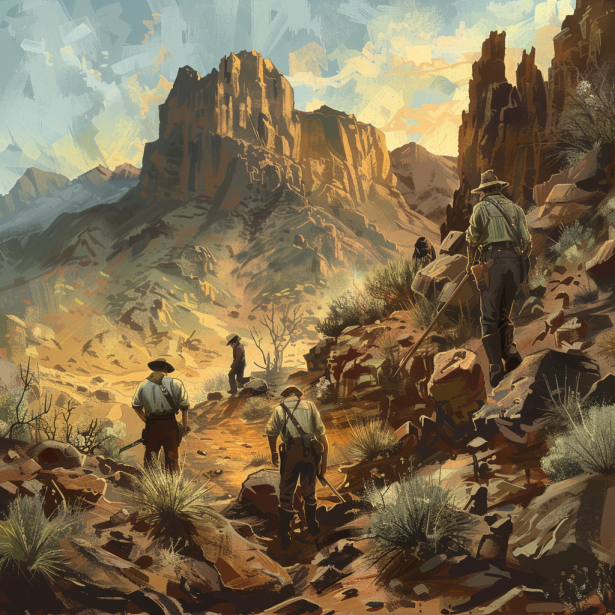Introduction
The Lost Dutchman’s Gold Mine is one of America’s most enduring legends. Situated in the rugged Superstition Mountains of Arizona, this fabled mine is said to hold a vast fortune in gold. The story dates back to the 19th century, when a German immigrant named Jacob Waltz—often referred to as “the Dutchman”—claimed to have discovered a rich vein of gold. Despite numerous expeditions and countless treasure hunters scouring the harsh terrain, the exact location of the mine remains elusive. Tales of mysterious deaths and disappearances add to the intrigue, making the Lost Dutchman’s Gold Mine a captivating mystery that continues to entice adventurers and dreamers alike.
The Origins of the Legend
Jacob Waltz: The Dutchman
Jacob Waltz, born in Germany around 1810, emigrated to the United States and eventually settled in Arizona. In the 1870s, he reportedly discovered a rich gold mine in the Superstition Mountains. Waltz kept the location of the mine a closely guarded secret, revealing it only to a few people before his death in 1891. His reticence and the fortune he allegedly found gave rise to the legend of the Lost Dutchman’s Gold Mine.
Early Clues and Maps
Before his death, Waltz is said to have shared cryptic clues and rough maps with a few trusted friends. These clues were often vague and contradictory, contributing to the difficulty in locating the mine. Despite this, they have fueled numerous expeditions and sparked the imaginations of treasure hunters for over a century.
The Superstition Mountains
Geography and Terrain
The Superstition Mountains, located east of Phoenix, Arizona, are known for their rugged terrain and harsh conditions. The area is characterized by steep cliffs, deep canyons, and dense vegetation, making exploration challenging and dangerous. This treacherous landscape has played a significant role in the mine’s elusiveness.
Cultural and Historical Significance
The Superstition Mountains have long been regarded as a place of mystery and legend. Native American tribes, such as the Apache, considered the mountains sacred and believed they were home to powerful spirits. This cultural significance adds another layer to the mystique surrounding the Lost Dutchman’s Gold Mine.
The Search for the Lost Mine
Notable Expeditions
Since the late 19th century, countless expeditions have set out to find the Lost Dutchman’s Gold Mine. Some of the most notable include:
- Adolph Ruth: In the 1930s, Ruth, a treasure hunter, disappeared while searching for the mine. His skull was later found with two bullet holes, fueling rumors of foul play and adding to the legend’s notoriety.
- Jesse Capen: A modern-day treasure hunter, Capen vanished in 2009 while searching for the mine. His remains were found years later, highlighting the dangers of the quest.
Modern Technology and Efforts
Advancements in technology, such as satellite imaging and ground-penetrating radar, have allowed modern treasure hunters to explore the Superstition Mountains more thoroughly. Despite these tools, the mine’s location remains undiscovered, keeping the legend alive.
Mysteries and Intrigues
Deaths and Disappearances
The search for the Lost Dutchman’s Gold Mine is fraught with tales of mysterious deaths and disappearances. Some believe the mine is cursed, while others attribute the dangers to the harsh and unforgiving terrain. These stories have only added to the mine’s mystique and allure.
Cryptic Clues and Legends
Many of the clues left behind by Jacob Waltz are cryptic and open to interpretation. Phrases like “north of Weaver’s Needle,” “in the shadow of the Lost Dutchman’s cave,” and “where the sun hits the canyon walls” have led treasure hunters on countless wild goose chases, deepening the mystery.
Cultural Impact and Legacy
Books, Films, and Media
The legend of the Lost Dutchman’s Gold Mine has inspired numerous books, films, and documentaries. Works such as “The Killer Mountains” by Curt Gentry and “Thunder Gods Gold” by Barry Storm have kept the story in the public eye, while TV shows and movies have dramatized the hunt for the lost treasure.
Tourism and Adventure
The legend attracts thousands of tourists and adventurers to the Superstition Mountains each year. Guided tours, hiking trails, and museums dedicated to the Lost Dutchman provide enthusiasts with a taste of the legend and an opportunity to explore the storied landscape.
Conclusion
The Lost Dutchman’s Gold Mine remains one of America’s most captivating legends. The tale of Jacob Waltz and his secret gold mine continues to intrigue and inspire adventurers from around the world. Despite the dangers and the countless expeditions that have come up empty-handed, the mystery endures. As long as the Superstition Mountains stand, the legend of the Lost Dutchman’s Gold Mine will remain a beacon for those driven by the lure of hidden treasure and the thrill of the unknown.
FAQs
Who was the Lost Dutchman?
The Lost Dutchman was Jacob Waltz, a German immigrant who claimed to have discovered a rich gold mine in the Superstition Mountains of Arizona in the late 19th century.
Where are the Superstition Mountains located?
The Superstition Mountains are located east of Phoenix, Arizona, and are known for their rugged terrain and harsh conditions.
What are some notable expeditions in search of the mine?
Notable expeditions include those by Adolph Ruth in the 1930s and Jesse Capen in 2009. Both treasure hunters disappeared under mysterious circumstances while searching for the mine.
What theories exist about the mine’s location?
Theories about the mine’s location often reference cryptic clues left by Jacob Waltz, such as being “north of Weaver’s Needle” or “in the shadow of the Lost Dutchman’s cave.”
Why is the Lost Dutchman’s Gold Mine significant?
The mine is significant due to its legendary status, the mystery surrounding its location, and the numerous tales of treasure hunters who have sought and failed to find it, often encountering danger along the way.
How has the legend impacted culture and tourism?
The legend has inspired books, films, and documentaries, and attracts thousands of tourists and adventurers to the Superstition Mountains each year, contributing to the local culture and economy.

